THE GREAT WAR 1914-1918
KNIGHTS OF THE SKIES
Many variations of aircraft engine starting have been used since the Wright brothers made their first powered flight in 1903. The methods used have been designed for weight saving, simplicity of operation and reliability. Early piston engines were started by hand, with geared hand starting, electrical and cartridge-operated systems for larger engines being developed between the wars.
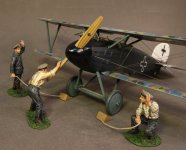
Hand starting of aircraft piston engines by swinging the propeller is the oldest and simplest method, the absence of any onboard starting system giving an appreciable weight saving. Positioning of the propeller relative to the crankshaft is arranged such that the engine pistons pass through top dead centre during the swinging stroke.
As the ignition system is normally arranged to produce sparks before top dead centre there is a risk of the engine kicking back during hand starting, to avoid this problem one of the two magnetos used in a typical aero engine ignition system is fitted with an 'impulse coupling', this spring-loaded device delays the spark until top dead centre and also increases the rotational speed of the magneto to produce a stronger spark. When the engine fires, the impulse coupling no longer operates and the second magneto is switched on. As aero engines grew bigger in capacity (during the interwar period), single-person propeller swinging became physically difficult, ground crew personnel would join hands and pull together as a team or use a canvas sock fitted over one propeller blade, the sock having a length of rope attached to the propeller tip end. Note that this is different from the manual "turning over" of radial piston engine, which is done to release oil that has become trapped in the lower cylinders prior to starting, to avoid engine damage. The two appear similar, but while hand starting involves a sharp, strong "yank" on the prop to start the engine, turning over is simply done by turning the prop through a certain set amount.
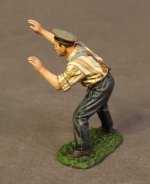
GGC-33
KNIGHTS OF THE SKIES,
GERMAN “HAND STARTER”
(1pc)
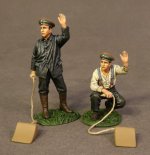
GGC-34
KNIGHTS OF THE SKIES,
GERMAN “CHOC MEN”,
(2pcs)
THE GREAT WAR 1914-1918
A despatch rider (or dispatch) is a military messenger, mounted on horse or motorcycle (and occasionally in Egypt during World War I, on camels
Despatch riders were used by armed forces to deliver urgent orders and messages between headquarters and military units. They had a vital role at a time when telecommunications were limited and insecure. They were also used to deliver carrier pigeons.
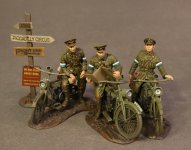
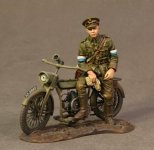
GWB-19A
THE GREAT WAR, 1914-1918,
Royal Engineers Signal Service(RESS),
DESPATCH RIDER ON MOTORBIKE,
(1pc)
In the British Army, motorcycle despatch riders were first used in the World War I by the Royal Engineers Signal Service. When the War Department called for motorcyclists to volunteer with their machines for despatch work at the start of August 1914, the response was huge
The London office had 2000 more applicants than places, and a similar response was reported in regional centres around the country. If a rider and machine were approved then £10 was paid immediately, £5 to be paid on discharge (unless due to misconduct), and pay was 35s per week. The motor cycle would be taken over at valuation price, or would be replaced with a new one at the close of operations. Enlistment was for one year or as long as the war might last. The preference was for 500cc single cylinder machines and the horizontally-opposed twin cylinder. All machines had to have a "change speed gear". A list of spare parts was also required to be carried.
**PLEASE CONTACT YOUR LOCAL DEALER FOR FURTHER INFORMATION**
KNIGHTS OF THE SKIES
Many variations of aircraft engine starting have been used since the Wright brothers made their first powered flight in 1903. The methods used have been designed for weight saving, simplicity of operation and reliability. Early piston engines were started by hand, with geared hand starting, electrical and cartridge-operated systems for larger engines being developed between the wars.

Hand starting of aircraft piston engines by swinging the propeller is the oldest and simplest method, the absence of any onboard starting system giving an appreciable weight saving. Positioning of the propeller relative to the crankshaft is arranged such that the engine pistons pass through top dead centre during the swinging stroke.
As the ignition system is normally arranged to produce sparks before top dead centre there is a risk of the engine kicking back during hand starting, to avoid this problem one of the two magnetos used in a typical aero engine ignition system is fitted with an 'impulse coupling', this spring-loaded device delays the spark until top dead centre and also increases the rotational speed of the magneto to produce a stronger spark. When the engine fires, the impulse coupling no longer operates and the second magneto is switched on. As aero engines grew bigger in capacity (during the interwar period), single-person propeller swinging became physically difficult, ground crew personnel would join hands and pull together as a team or use a canvas sock fitted over one propeller blade, the sock having a length of rope attached to the propeller tip end. Note that this is different from the manual "turning over" of radial piston engine, which is done to release oil that has become trapped in the lower cylinders prior to starting, to avoid engine damage. The two appear similar, but while hand starting involves a sharp, strong "yank" on the prop to start the engine, turning over is simply done by turning the prop through a certain set amount.

GGC-33
KNIGHTS OF THE SKIES,
GERMAN “HAND STARTER”
(1pc)

GGC-34
KNIGHTS OF THE SKIES,
GERMAN “CHOC MEN”,
(2pcs)
THE GREAT WAR 1914-1918
A despatch rider (or dispatch) is a military messenger, mounted on horse or motorcycle (and occasionally in Egypt during World War I, on camels
Despatch riders were used by armed forces to deliver urgent orders and messages between headquarters and military units. They had a vital role at a time when telecommunications were limited and insecure. They were also used to deliver carrier pigeons.


GWB-19A
THE GREAT WAR, 1914-1918,
Royal Engineers Signal Service(RESS),
DESPATCH RIDER ON MOTORBIKE,
(1pc)
In the British Army, motorcycle despatch riders were first used in the World War I by the Royal Engineers Signal Service. When the War Department called for motorcyclists to volunteer with their machines for despatch work at the start of August 1914, the response was huge
The London office had 2000 more applicants than places, and a similar response was reported in regional centres around the country. If a rider and machine were approved then £10 was paid immediately, £5 to be paid on discharge (unless due to misconduct), and pay was 35s per week. The motor cycle would be taken over at valuation price, or would be replaced with a new one at the close of operations. Enlistment was for one year or as long as the war might last. The preference was for 500cc single cylinder machines and the horizontally-opposed twin cylinder. All machines had to have a "change speed gear". A list of spare parts was also required to be carried.
**PLEASE CONTACT YOUR LOCAL DEALER FOR FURTHER INFORMATION**

